電影訊息
突變第三型--The Thing [1982]
編劇: 比爾蘭卡斯特
演員: 寇特羅素 Wilford Brimley T.K. Carter David Clennon Keith David
怪形/突变第三型
導演: 約翰卡本特編劇: 比爾蘭卡斯特
演員: 寇特羅素 Wilford Brimley T.K. Carter David Clennon Keith David
電影評論更多影評

2013-02-14 19:56:51
Screening report of The Thing
FS 201
5 Feb 2013
The Thing and Noel Carroll’s Why horror?
Curiosity
According to Carroll, 「the horror story is driven explicitly by curiosity」 (35). Before the monster finally shows up, there are a lot scenes building up audience’s curiosity and foreshadowing the upcoming disaster. The opening wide shot is about twenty seconds long, showing only the snow mountains, which may make one ask where it is and what has happened here before. Then the helicopter appears from afar and finally the camera moves to reveal more about this place. The continuous shots at the running husky bring us to the main characters and major scene’s location, but the audiences and the characters still don』t know what has happened. This scene produces the initial curiosity attracting audiences to see what horror it will be. The curiosity of the characters is about finding out why the Norwegians tried to kill the husky. A lot of shots of that husky definitely reveal there is something wrong with it, but none of them shows what disaster the dog will cause. After the monster shows up, audience’s curiosity is the same as the characters, which is to find out who the monster is imitating now. These curiosities move the plot forward to the revelation of answers, by showing step by step what happened, who the monster is, how to find out and deal with it. The audience is curious because they are not knowledgeable about the monster, and the process to make the unknown knowable is filled with suspense and shocks. However, the open ending leaves the ultimate curiosity unsolved, allowing the audience to imagine more possibilities. Maybe that is the charm of open ending- to keep the audience scared, curious and worried about what happened to the remaining two people (if they are in fact remaining), and also leaves audiences themselves to decide whether a good ending or a bad one.
Drama of proof
According to Carroll, 「horror stories…are dramas of proving the existence of the monster and disclosing (most often gradually) the origin, identity, purposes and powers of the monster」 (35). The Thing completely follows this concept. The Norwegian man, who shoots the husky, drives characters to find out the existence of the monster first. Then, they dissect the monster to get to know more about its identity. Then the spaceship, which crushed the earth millions year ago, is found and reveals the monster’s origin. Then the scientific analysis is conducted in the computer and reveals its properties and powers, which is to imitate other life-form just with one cell. Then, just as Carroll indicates that once the monster is established, the characters have to confront it and try to destroy it, the narrative is exactly follows this line. The different forms of monsters prove its power and vitality, but what’s more terrifying is when the people don』t trust each other.Since it is hard to determine who becomes the monster, the doubt, skepticism and fear of being the thing surrounds these people. The whole movie is about not only the proof of the monster’s existence and elimination (probably). But it is also about the proof of human being’s nature of skepticism of others and self, the instinct of self- protection and killing of what is threating in this isolated, cold, and severe environment.
Monster as 「impure」
As Carroll indicates that impurity is an essential feature of art- horror, the monster is regarded as the transgression of the conceptual and cultural schema. Since the monster exists in outer space before human civilization developed, it is undoubtedly excluded from human’s cultural schema. Also due to the fact that it has evolved during another million years, its life-form is advanced and hard for human beings to notice. It digests, absorbs, and shapes its own cell to imitate other lives perfectly. It is not a human, but it can imitate a human or any kind of life-form. Its appearance is various but is disgusting and disturbing. Different from human beings, it is inside out. Its subcutaneous tissues and some organs are exposed to the air. The interstitial fluid, body fluid and blood are a sticky fluid. It maintains parts of each prey’s identity, but totally is an anomalous being. It is living thing based on a dead victim. It has no regular form, but can change to anything else. Besides, it is human’s instinct to fear and be disgusted with the wound, organs in blood, sticky liquid, and other dangerous elements like sharp teeth and one open eye. In addition, when the monster can be anyone else, everyone is worried and doubts others, and even themselves, which builds up more suspense and fear within characters. Thus this perfectly impure monster does a good job in engendering both disgust and curiosity.
評論

